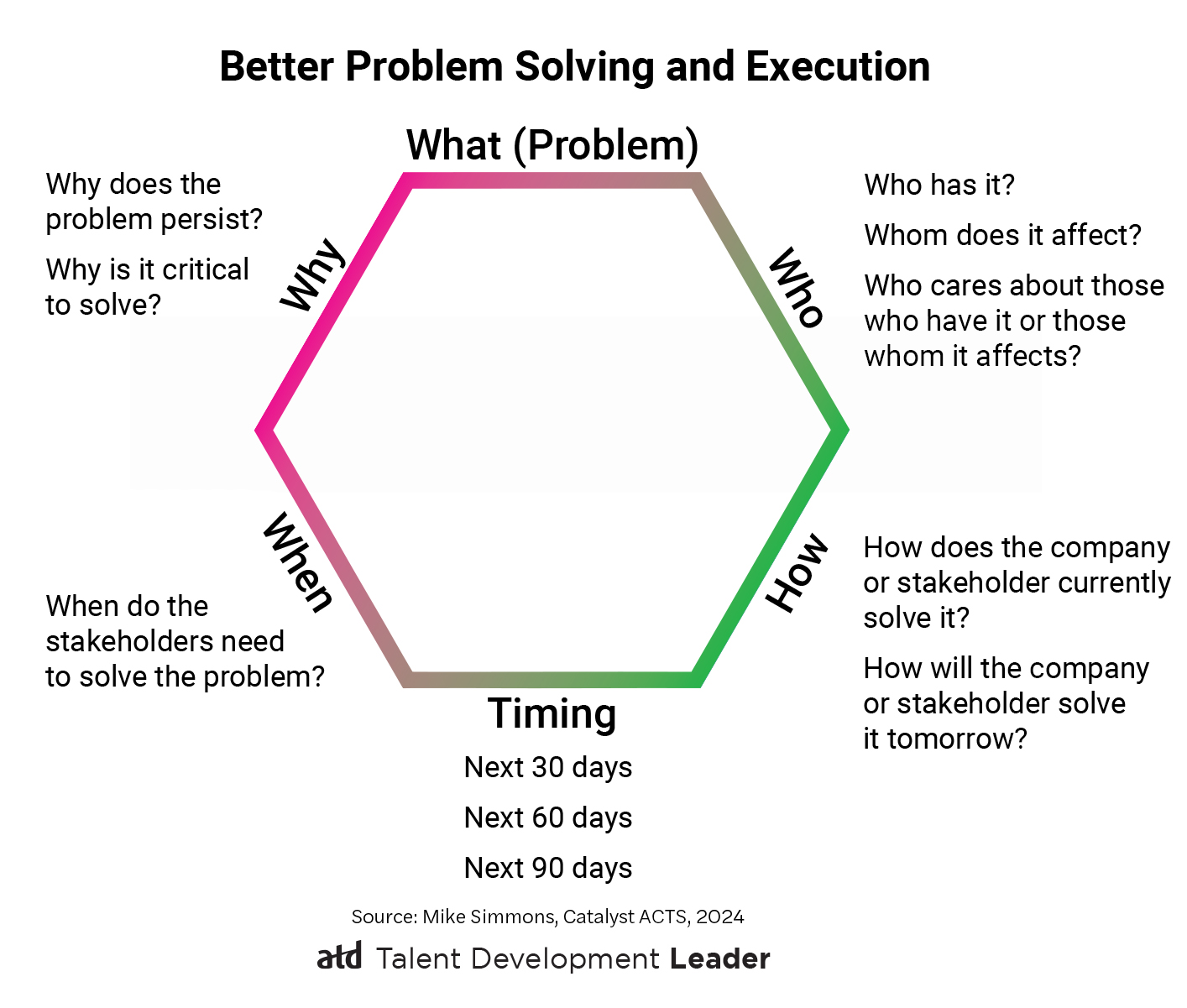Talent Development Leader
Get to the 'Yes'
Three strategies for securing business buy-in
Thu May 22 2025

Limited resources are a reality for many talent development teams. The struggle to implement new technologies and initiatives requires buy-in from business leaders with whom training professionals must foster partnerships. But those conversations often fall short because TD leaders use training language rather than business language. The resulting communication gap can hinder obtaining the support and funding we need.
But what if there was a different approach? By applying three key strategies—creating a structured business plan, understanding your stakeholders’ perspectives, and leveraging storytelling—you can close the gap, gain buy-in, and ultimately drive meaningful change.
Strategy 1: Build a business plan
Use a clear framework to create internal business proposals that resonate with decision makers. Focus on defining the problem rather than jumping straight to the solution.
Start with the problem. In every proposal, begin by answering: What problem are we trying to solve? Business leaders don’t care about the solution until they fully understand the concern. It’s tempting to push a new technology or program, but first explain, in detail, the specific business problem the initiative will address.
Gain perspective. Determine whom the problem affects. Who has the problem? Who is affected by it? Who cares about those affected by it?
Revisit the what and why from the perspective of each stakeholder. Aligning the problem with their business priorities and highlighting the risks of inaction can help justify their support. Those individuals are potential champions; they are likely responsible for key profit centers within the organization, and their investment in the problem stems from a desire to protect or grow revenue.
Ask questions. After mapping out the key players, pose:
Why does this problem persist? The answers are critical to understanding not only the issue itself but also the underlying factors contributing to it.
Why is it important to solve the problem? Understanding and articulating the business impact of solving—or not solving—the issue will strengthen your case.
How are individuals currently solving the problem? If you are unable to uncover the current how, you may be attempting to solve a problem that no one cares about. If they are attempting to solve the problem in an ineffective way, you may have an opportunity to justify change.
When do the stakeholders need to solve the problem? Reveal a sense of urgency. If you have a when, you can start to build out your project plan.
Develop the timeline. What needs to happen in the short term (30 days), the medium term (60 days), and the long term (90 days or more)? Set clear milestones, demonstrate a concrete plan, and discuss realistic expectations to build credibility with decision makers.

Strategy 2: Understand business language
Even with a solid business plan, success hinges on how well you communicate it. To do that, speak in the stakeholders’ language.
The Four Ways of Seeing, adapted from the University of Foreign Military and Culture Studies, is a tool that uses four questions:
How do you see the stakeholder? Determine what their priorities and concerns are.
How does the stakeholder see themselves?
Identify what they view as their primary role and responsibilities within the company.
How does the stakeholder see you?
Uncover their perception of your role and how they view your contribution to the organization.
How do you see yourself?
Pinpoint your role in this context and how it aligns with the stakeholder’s view.
That framework puts you in the decision maker’s shoes, which accelerates empathy. The better you understand their concerns and priorities, the more effectively you can communicate and position your proposal to align with their goals.
In addition to the Four Ways of Seeing, a structured call-planning tool can further enhance your communication. Prepare answers to these questions before any meeting:
Who are you speaking with? What is their role?
What are their goals for the meeting or conversation? What are they trying to achieve, and how does it relate to your proposal?
What are your objectives? What do you want to learn, share, or achieve in this meeting?
What are your desired next steps? What outcomes do you want from this interaction?
Planning those elements in advance sets the stage for more productive conversations and enables you to better anticipate your audience’s needs.
Strategy 3: Leverage stories
People are naturally drawn to stories, and business leaders are no exception. Storytelling can help you connect emotionally with your audience and compel them to take action.
Your customer is the hero. In many cases, TD leaders mistakenly position themselves as the hero of the story. However, the real hero is the person or group experiencing the problem. Your role is to be the guide who helps them overcome challenges and achieve success. Think of classic storytelling arcs, such as Joseph Campbell’s Hero’s Journey or Donald Miller’s StoryBrand framework. In those narratives, the hero faces a challenge they cannot solve alone. They need a guide—someone with the expertise and a plan to help them succeed.
Position yourself as the guide and keep the business leader (or end user) as the protagonist. Focus on their needs, creating a more compelling case for change. They are the ones facing the obstacle, and your proposal offers the solution that helps them achieve their desired outcomes.
Create a clear plan for success. In storytelling, the guide provides a plan to avoid failure and achieve success. Clearly outline how your solution will lead to the stakeholder’s desired results. Demonstrate that you understand the problem and have a proven path to success.
A positive approach
Securing buy-in for TD initiatives doesn’t have to be a strain. By creating structured business plan proposals, understanding the perspectives and language of your stakeholders, and leveraging storytelling to compel change, you can build stronger business cases, communicate more effectively, and position your solutions in a way that aligns with the organization’s goals. Using those strategies will result in increasing your chances of gaining the resources and support you need to make a real impact—and you’ll find that getting a yes is not only achievable but also transformative for your company.
